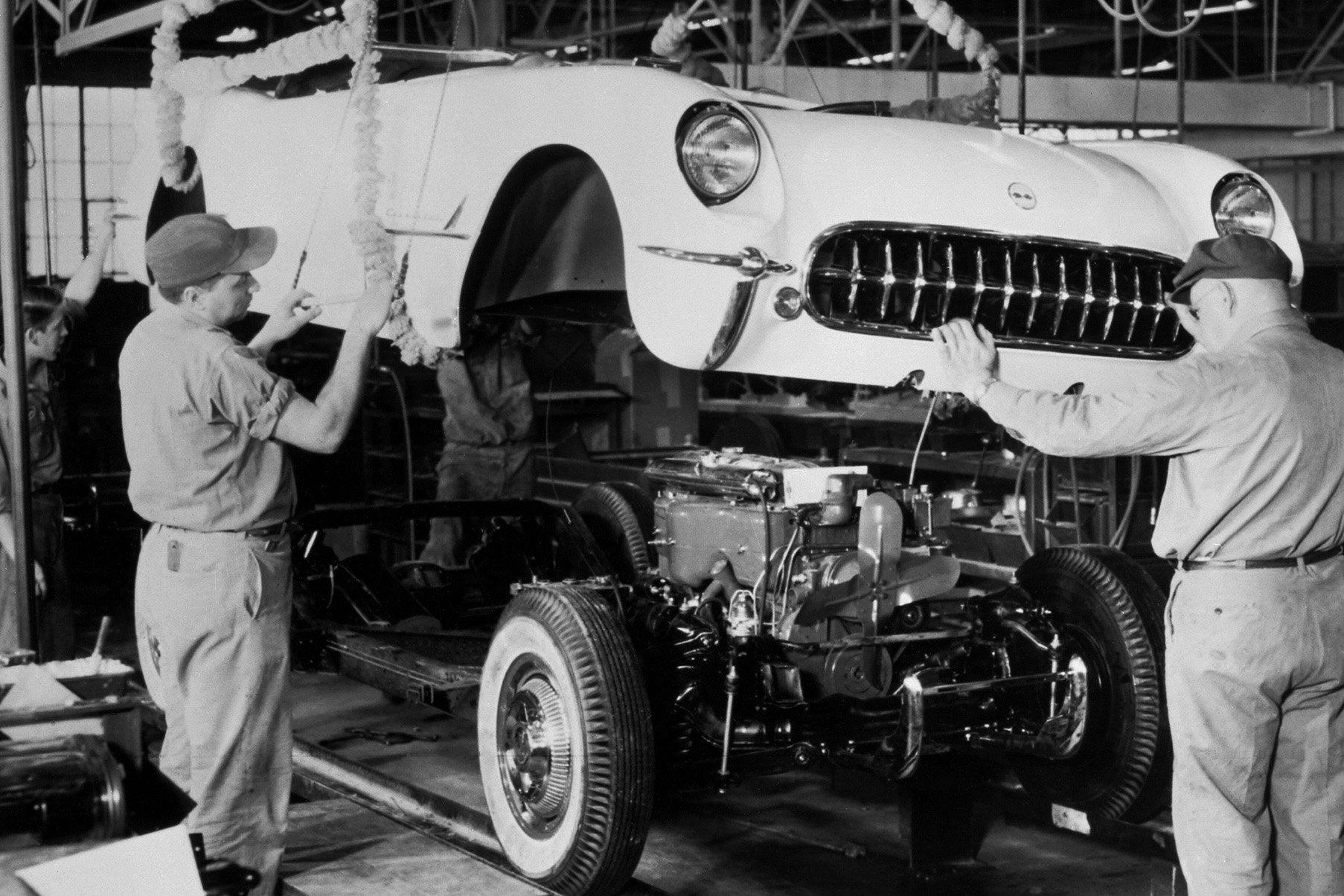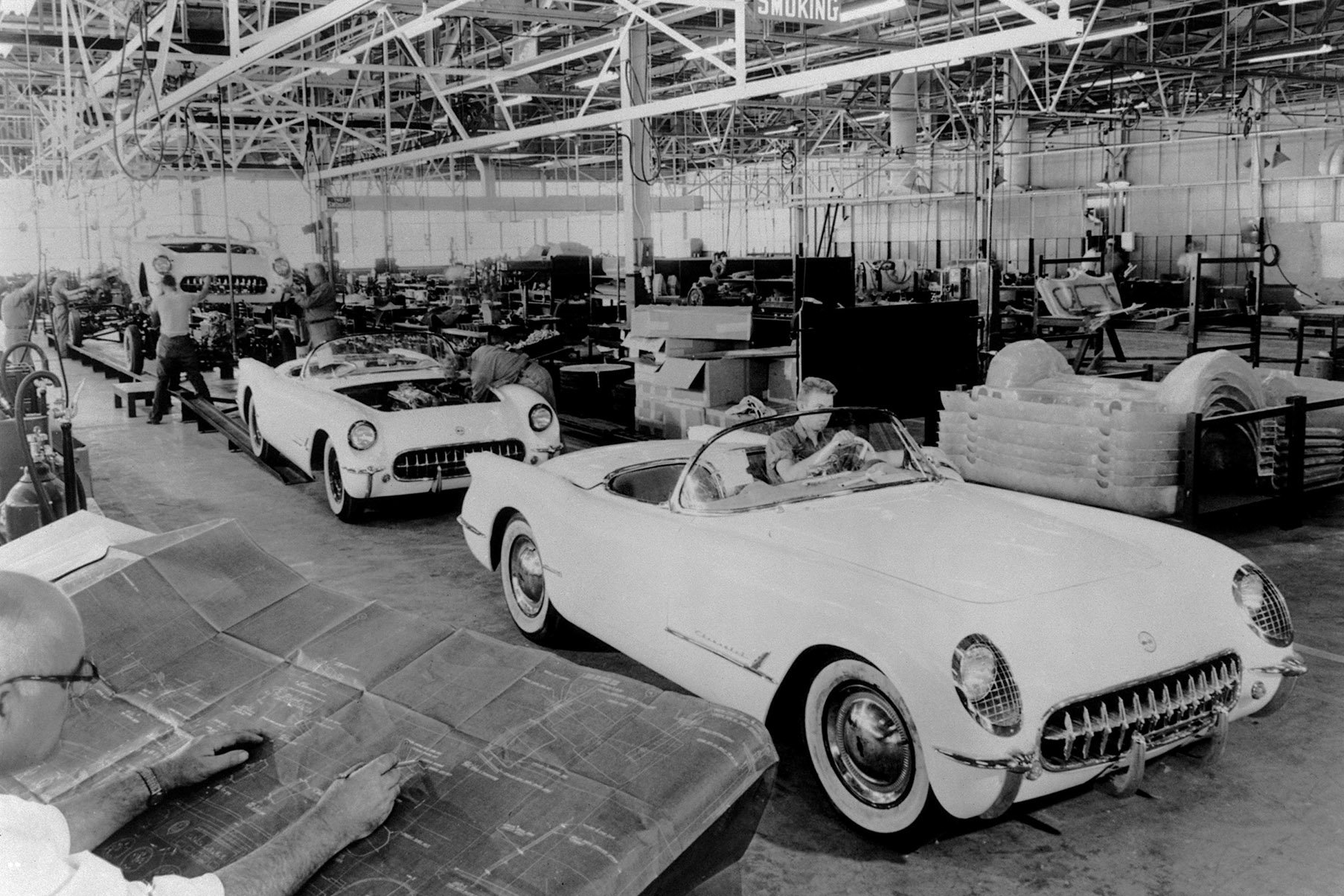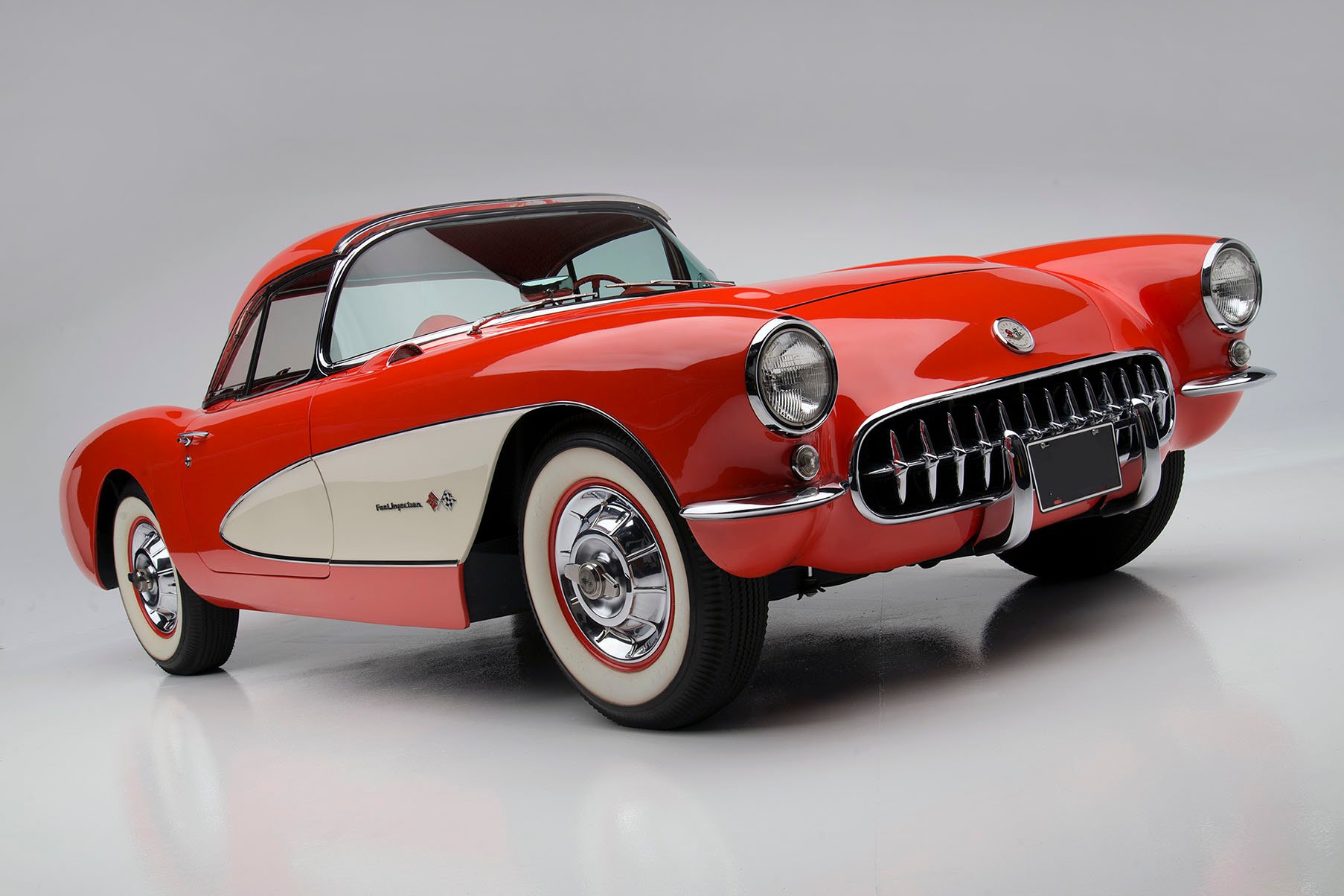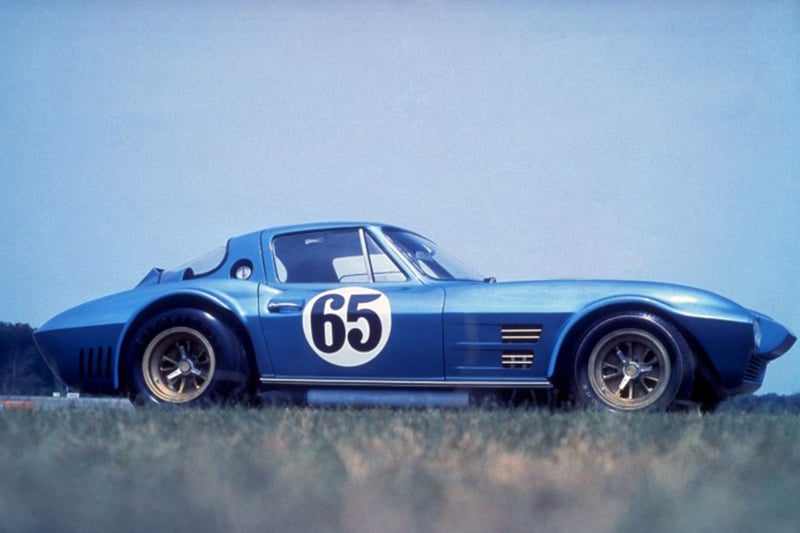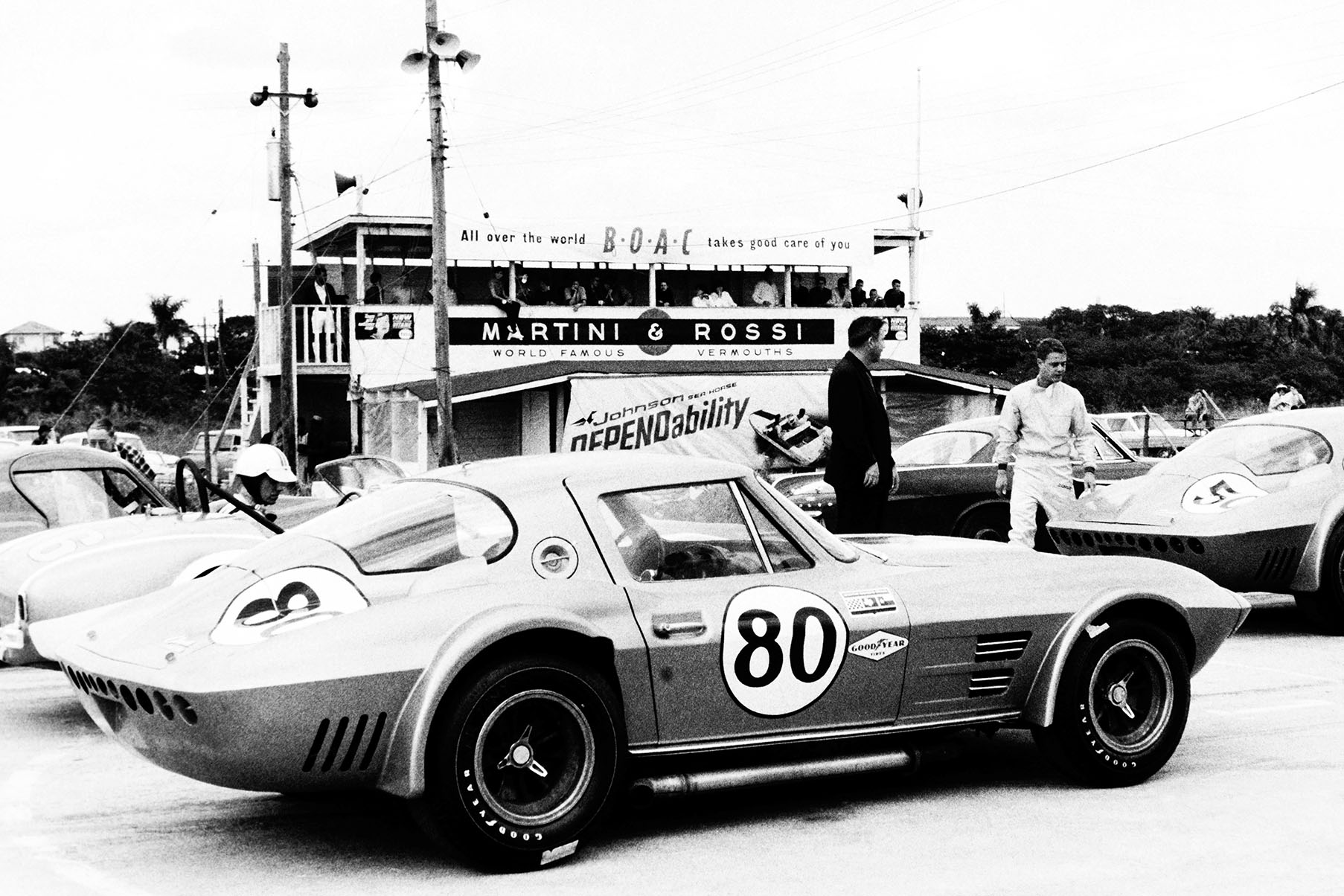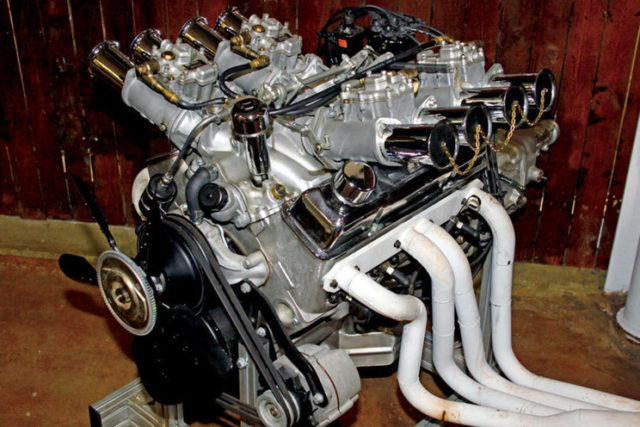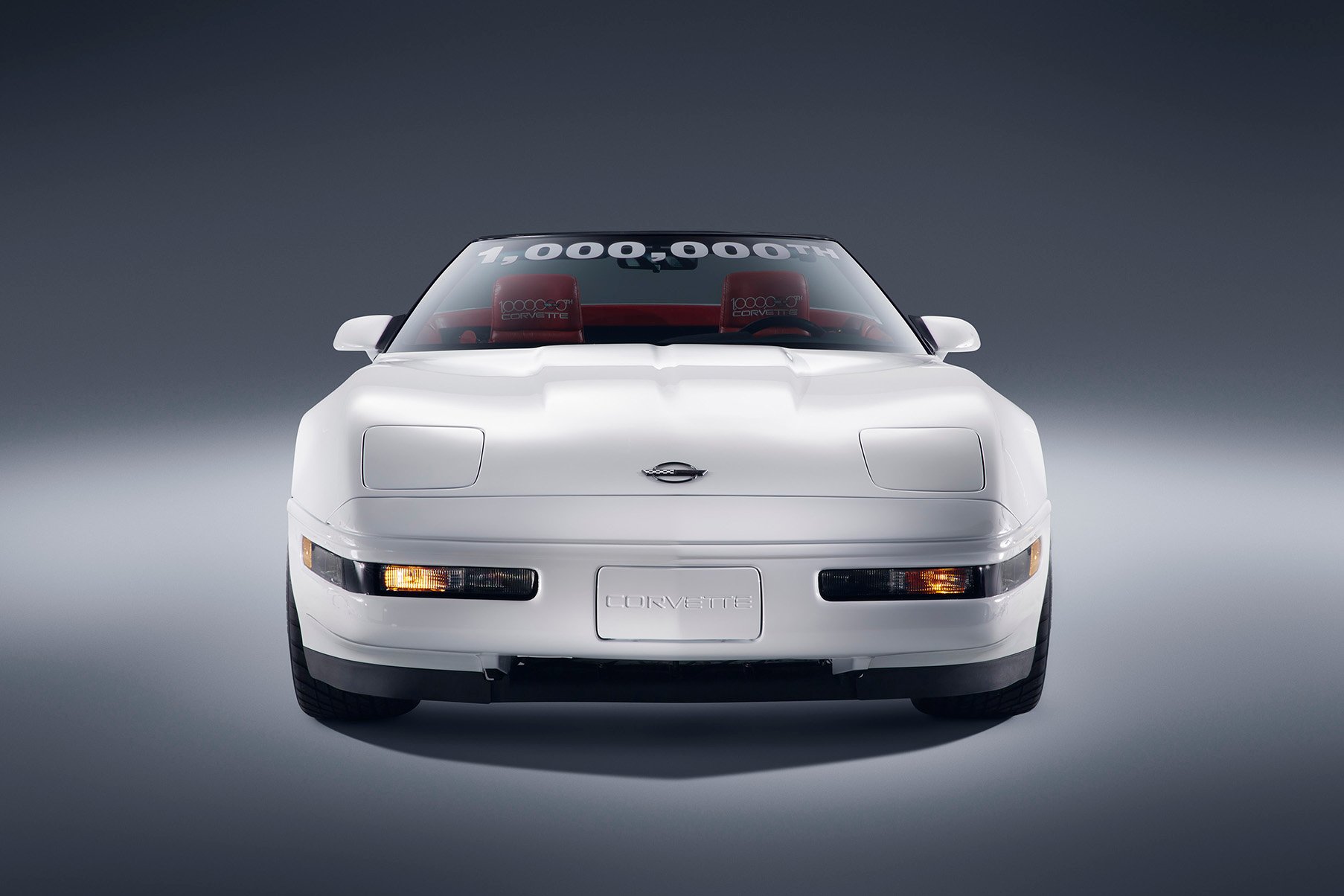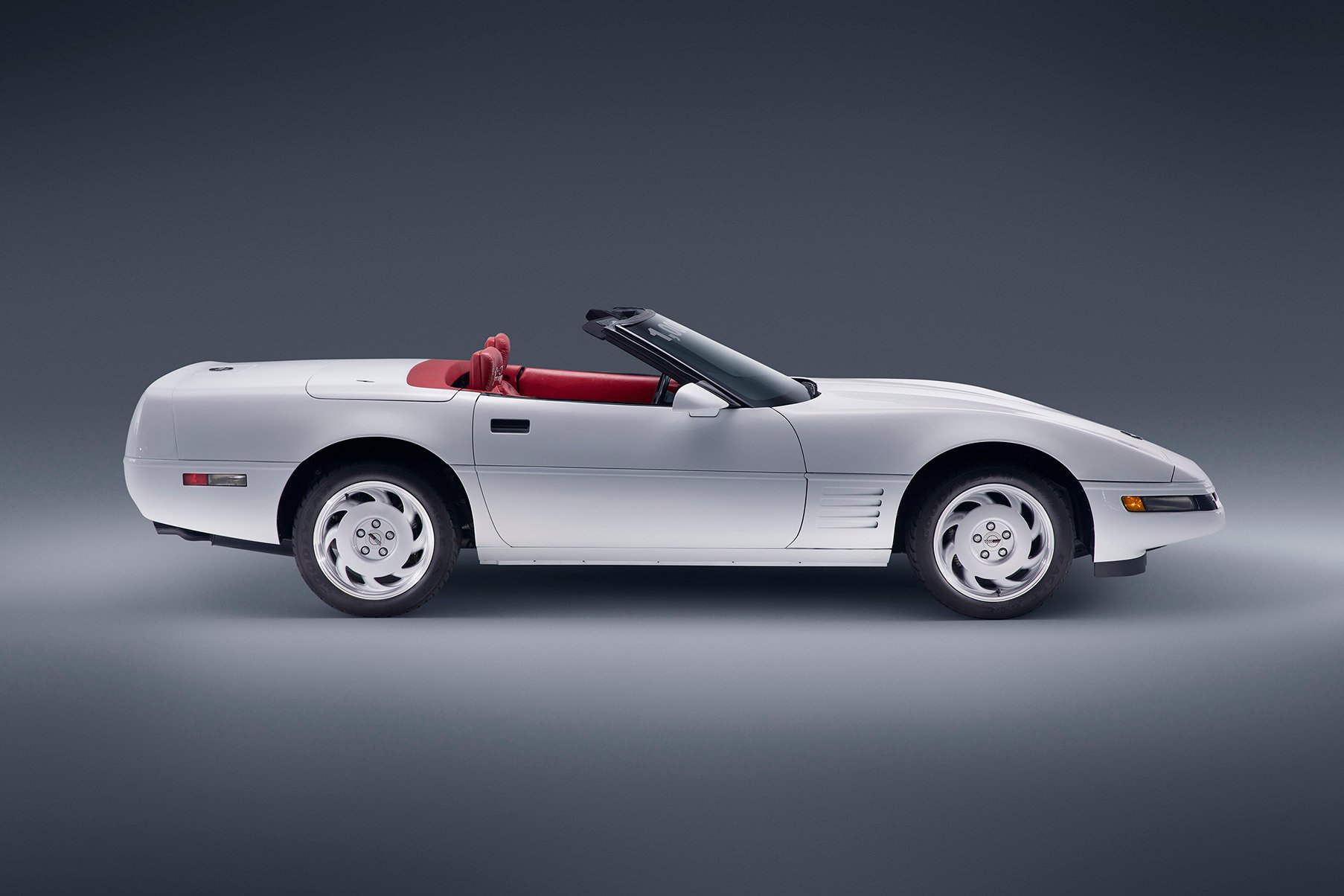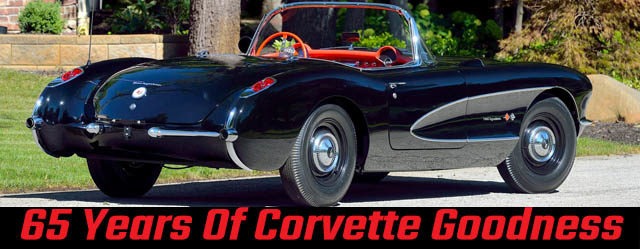 Chevrolet’s iconic sports car is set to mark its 65th anniversary very soon. And while Chevy has plans of its own to commemorate the momentous occasion, we thought this would be a good time to look back at five landmark moments in Corvette history to see how the car has evolved over the decades, and get a better sense of the road ahead.
Chevrolet’s iconic sports car is set to mark its 65th anniversary very soon. And while Chevy has plans of its own to commemorate the momentous occasion, we thought this would be a good time to look back at five landmark moments in Corvette history to see how the car has evolved over the decades, and get a better sense of the road ahead.
1953: The C1 Goes Into Production
Post World War II America had seen GIs returning to the U.S. from Europe with a newfound taste for sporty models that Jaguar and Alfa Romeo were producing at the time. But domestic automakers didn’t have a home-grown answer of their own, aside from the pricey Nash-Healy, and GM’s Harley Earl sought to change that. Earl went to GM’s top brass and explained the opportunity at hand, convincing them to develop a two-seater sports car that could compete with these European offerings at a price that middle-class Americans could afford.
Dubbed “Project Opel”, development of the first Corvette got underway in 1951, and the hand-built EX-122 pre-production Corvette prototype would make its first public appearance at the 1953 General Motors Motorama at the Waldorf-Astoria in New York City to wide acclaim, setting the stage for what would later become an institution for American high performance.
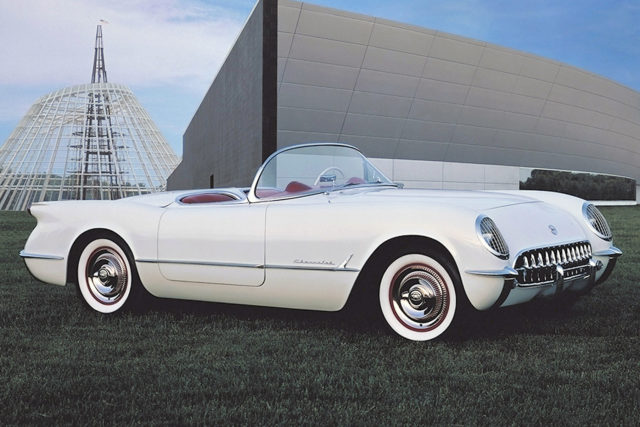
After seeing the excitement for the concept at 1953 GM Motorama, Chevrolet quickly put the fiberglass-bodied two-seater into production. But in order to do so they’d have to use garden-variety Chevrolet hardware under the curvaceous bodywork. Image: General Motors
GM’s brass saw the Corvette as a rather expensive gamble though, and its introduction didn’t go as smoothly as they might have hoped. To keep costs down they mandated that off-the-shelf Chevrolet passenger car components would be used, so the sole drivetrain combination available at the Corvette’s introduction was a 150 horsepower, 235ci inline six cylinder engine that was mated to a two-speed Powerglide automatic transmission, which resulted in less than thrilling performance.
A truck factory was hastily converted into the production plant for the new Corvette. But the all-new platform posed a number of challenges during assembly, and production methods would evolve as the car was being produced in 1953. This led to quality control issues that nearly spelled the end of the roadster, but a few well-timed outside factors brought it back from the brink. Images: General Motors
Adding to the Corvette’s teething issues was the fiberglass bodywork, a fairly exotic material at the time, along with assembly that was performed largely by hand in a converted truck factory in Flint, Michigan, which yielded wide variances in build quality.
Though it was off to a rocky start, the beauty of the roadster’s design was undeniable, and the Corvette would gain its footing in the marketplace a few years later.
1957: The Fuelie Is Born
Although the C1’s styling was an immediate sensation and the Corvette’s sports car proportions were ripe for performance, for the initial years of production the first-generation Corvette lacked the hardware to match the capability of its European rivals. The aforementioned inline six cylinder motor and its two-speed Powerglide automatic gearbox dished out a leisurely jaunt to 60 miles per hour from rest in 11.5 seconds.
But the addition of GM engineer and performance enthusiast Zora Arkus-Duntov to the Corvette project would have a profound effect on the car. Duntov, an avid road racer, knew GM would needed to step their game up significantly if the Corvette wanted to compete on the world stage.
Over the course of just a few years, the Corvette was comprehensively transformed, from the body work and build quality to the handling and braking.
The previous year had brought a number of positive changes to the Corvette, but the '57 model year is where the whole picture came together. A potent 283 cubic inch, fuel-injected V8 now graced the options sheet, as did a close-ratio four-speed manual gearbox, and together the Corvette was now running with the fastest cars money could buy. Images: General Motors
But above all else, it was the introduction of the new 283ci V8 with its optional Rochester fuel injection system that would solidify the Corvette as a world-class sports car in 1957. Underrated at 283 horsepower for marketing purposes, the new “Fuelie” 283 V8 produced more than one horsepower per cubic inch, the first mass-produced engine to do so.
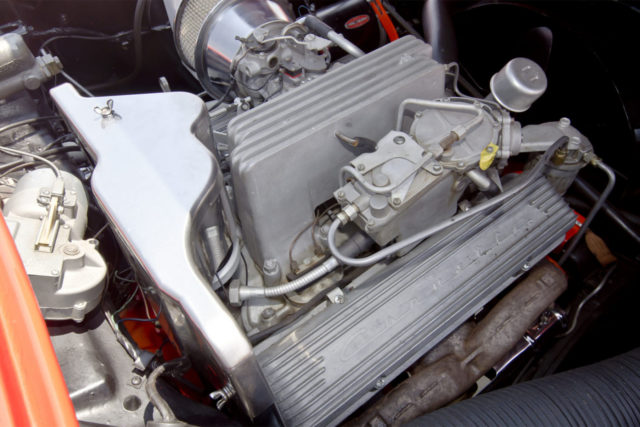
Though initially a finicky design, the Ram-Jet mechanical fuel injection that was installed on the Corvette’s most potent V8 for 1957 helped stake its claim in the upper realms of the sports car food chain. Image: Mecum
And the new motor delivered on its performance promise. Along with the massive mechanical advantage offered by the recent addition of an optional four-speed gearbox and Chevrolet’s new Positraction limited slip differential, the ’57 Corvette Fuelie clocked an astounding 5.7 second sprint to 60 mph on the way to a 14.3 second quarter mile time during independent testing, solidifying the Corvette’s place among the most capable sports cars in production at the time.
1963: The Grand Sport Program
While the Corvette had already proven itself as a potent sports car by the end of the first generation car’s production run, as international sports car racing was becoming big business (and a highly visible marketing tactic) by the early 1960s, Duntov and his team wanted to take the Corvette several steps further.
Developed in secret in 1962 due to General Motors’ corporate-wide ban on factory-backed racing at the time, the plan was to build enough of Duntov’s purpose-built race cars to homologate the Grand Sport for use in various race classes and sell these chassis directly to privateer teams as a way of skirting around GM’s anti-motorsport edict.
While it may have looked like a track-focused package for the standard Corvette, underneath the familiar bodywork of the C2 Corvette Grand Sport was a bespoke chassis and powertrain setup that was purpose-built for road course racing. Images: Hemmings
But unlike the upcoming Corvette Z06, this was not an effort to build a track-capable road car. Instead, the Grand Sport was designed from the ground up to be used in motorsport. And Duntov knew that if the Corvette was going to be competitive with Ford’s new light-weight Cobra on the world stage of motorsport, it was going to need some serious high performance firepower.
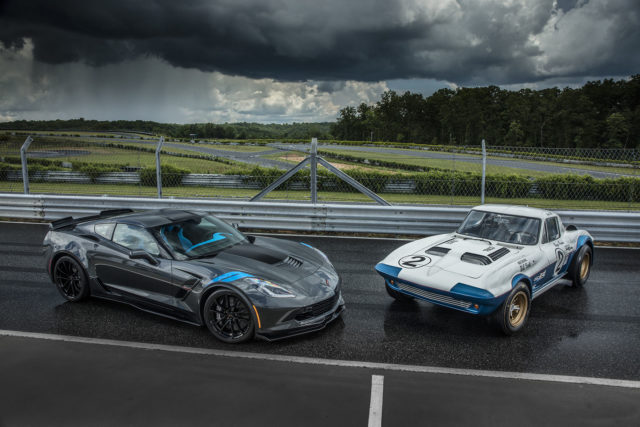
Though the C2 Grand Sport would go out of production after only five examples were built, the moniker has been revived a few times in the years since, starting in 1996 with the C4 and most recently with a track-focused, naturally-aspirated version of the C7. Image: General Motors
Known as “The Lightweight” internally during development, overall mass was down nearly half a ton from the standard car by way of the removal of any and all content and components not related to performance while thinner, hand-laid fiberglass bodywork, and lightweight aluminum replaced steel throughout the car’s internal structure. It received a bespoke powerplant as well – a new, all-aluminum 377 cubic-inch small block V8 sporting four Weber side-draft carburetors and a cross-ram intake, good for 550 horsepower at 6,400 rpm. Disc brakes were installed at all four corners while the standard rolling stock was ditched in favor of magnesium wheels and racing rubber.
Even while still fine-tuning the car, the Grand Sport showed serious promise. The purpose-built Corvette proved so capable during testing that it ran within striking distance of a track record at Sebring, a revelation that made its way back to GM Chairman Frederic Donner, who promptly but the kibosh on the project.
Duntov’s plan to build 125 examples of the Grand Sport was cut tragically short as a result, which in turn prevented his team from building the 125 examples required to homologate the car for the FIA’s production-based racing class they’d designed it for. Instead, it would be forced to compete in the Prototype class with with full-blown race chassis like the Chaparral and “Birdcage” Maserati – designs that never had an origin in anything other than motorsport – and the Grand Sport never got the chance to officially take Shelby’s Cobra to task. However, two of the five Grand Sports that were built would go on to beat the Cobras in the Governor’s Cup and Nassau Trophy races that year in the hands of privateer teams (who’d been loaned the cars by Duntov), finishing third and fourth behind a pair of prototype racers.
1992: The One Millionth Corvette Is Built
On July 2nd, 1992, a white LT1 roadster with a red interior and a black roof – the same aesthetic configuration that C1 debuted in 39 years prior – rolled off the assembly line in Bowling Green, Kentucky, the one millionth Corvette built to date.
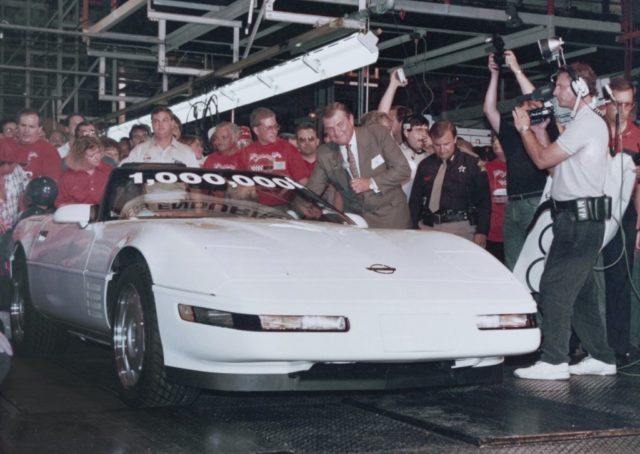
The one millionth Corvette produced, photographed on shortly after rolling off the assembly line on July 2nd, 1992. Image: General Motors
A formal ceremony was held to celebrate the occasion with Zora Arkus-Duntov on hand to take part in the festivities that marked a true milestone moment for the iconic sports car.
In a bizarre twist of fate, 23 years later, that Corvette would be one of the vehicles that was severely damaged when a 40 foot sinkhole opened up without warning one night in the National Corvette Museum in Bowling Green, Kentucky, in February of 2014. All told, eight museum-worthy Corvettes were swallowed up in the unusual incident.
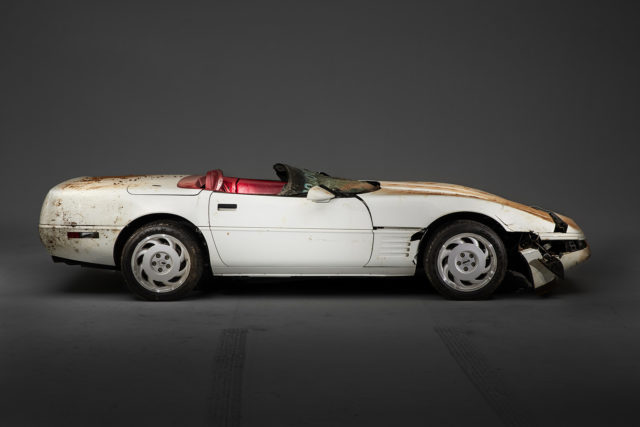
The 1 millionth Corvette produced, photographed shortly after its recovery from the sinkhole that opened up beneath the National Corvette Museum, in Bowling Green, Ky., on Feb. 12, 2014. Image: General Motors
However, Chevrolet vowed to repair this important piece of Corvette history, and after more than four months and 1,200 man-hours of painstaking restoration, the one millionth Corvette returned to its rightful place in the museum, good as new.
“As the one and only 1 millionth Corvette, its preservation was important to us as the designers of the vehicle – and as Corvette enthusiasts,” said Ed Welburn, vice president of GM Global Design said at the time. “The damage was significant in many ways; however we have one of the most highly skilled specialty shops and team of people in the industry, so they were fully prepared to take on the challenge.”
The one millionth Corvette, post-restoration. Images: General Motors
Five of the other Corvettes damaged in the incident have remained in their as-recovered state to preserve the historical significance of the cars, as well as to take part in a sinkhole-themed display at the museum.
2014: The Most Powerful Factory-Produced Vehicle In General Motors’ History, The C7 Z06, Is Unveiled
The debut of the C7 brought both the Stingray and LT monikers back into the fold after long hiatuses, and the all-new seventh-generation Corvette paired seriously capability with a compelling aesthetic and cutting edge technology.
The Z51 package for the LT1-powered Stingray made the C7 Corvette a formidable sports car package right out of the gate, but Chevrolet wasted little time before unleashing the monstrous C7 Corvette Z06 upon the world.
With the outgoing C6 ZR1 boasting 638 horsepower and lateral grip exceeding 1.1g, the new C7 Z06 had big shoes to fill. When optioned with the Z07 package it did just that, not only delivering more power from its LT4 V8, but also more lateral grip at 1.2g, providing it with enough capability to lap the test track at GM's proving grounds a full second faster than the C6 ZR1. Images: General Motors
Debuting at the 2014 Detroit Auto Show, the C7 Z06 boasted a wider stance, grippier rubber, more aggressive suspension tuning, bigger brakes, additional aerodynamic elements for increased downforce, and the new boosted LT4 engine.
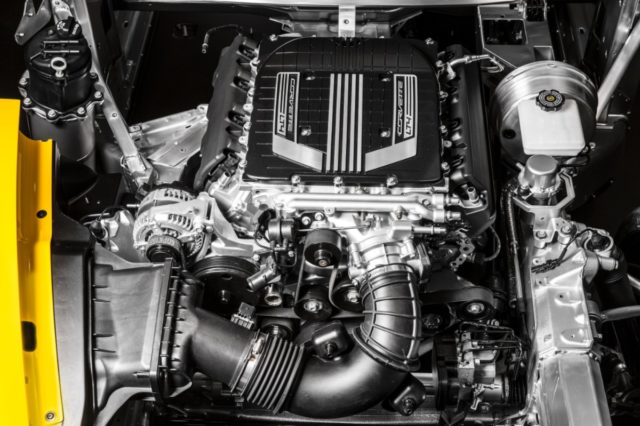
The Z06’s supercharged 6.2-liter LT4 is shared with the 2016 Cadillac CTS-V as well as the 2017 Camaro ZL1. Image: General Motors
The direct-injected, 6.2-liter, supercharged LT4 V8 churns out 650 horsepower and 650 pound-feet of torque – higher output than any other factory-produced vehicle in General Motors’ history, which spans over a century. Equipped with the optional 8-speed automatic gearbox, Chevrolet test drivers coaxed the Z06 to 60 mph in just 2.95 seconds on its way to a 10.95 quarter mile, and then logged the shortest braking distance of any GM production vehicle ever tested (99.6 feet) for good measure.
While that’s more than enough hair-raising performance for any normal human being, Chevrolet doesn’t look to be resting on their laurels any time soon, as a new ZR1 variant has been spied testing both domestically and at Germany’s famed Nurburgring road course sporting even more aggressive bodywork and, we predict, even more horsepower.
And although it’s far from officially confirmed, after literally decades of speculation, numerous signs point toward Chevrolet finally unleashing a mid-engined Corvette upon the world, likely as a 2019 model. Recent news that Chevrolet will be suspending all Corvette factory tours for 18 months beginning in June only adds to the likelihood that Chevrolet has some radical changes in store for Corvette in the near future.
Here’s to another 65 years of an American sports car icon.
What are your favorite milestones from the Corvette’s 65 years in production? Share your thoughts in the comments below!



